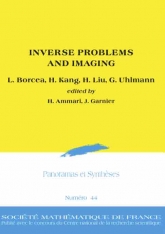
- Consulter un extrait
- Année : 2014
- Tome : 44
- Format : Électronique, Papier
- Langue de l'ouvrage :
Anglais - Class. Math. : 35B30, 35B40, 35J05, 35J47, 35R30, 35R30, 35R60, 60F05, 76B15, 78M35
- Nb. de pages : xii+136
- ISBN : 978-2-85629-793-3
- ISSN : 1272-3835
La conférence ‘problèmes inverses et imagerie' s'est tenue à Paris, à l'Institut Henri Poincaré du 20 au 22 Février 2013. Elle a été organisée sous les auspices de la Société Mathématique de France (SMF) comme une session des ‘États de la Recherche'. Son principal objectif était de présenter les développements récents sur les problèmes inverses et l'imagerie. La plupart de ces développements résultent d'interactions entre plusieurs domaines des mathématiques : analyse et contrôle des équations aux dérivées partielles, analyse stochastique, statistique, analyse multi-échelles. Les trois mini-cours donnés par Liliana Borcea (Université du Michigan, États-Unis), Hyeonbae Kang (Université Inha, Corée), et Gunther Uhlmann (Université de Washington, États-Unis) peuvent être considérés comme de parfaites illustrations de ces interactions fructueuses. Liliana Borcea a donné un cours sur l'imagerie en milieux aléatoires, plus exactement sur l'imagerie dans des guides d'ondes aléatoires. Elle propose différentes méthodes d'imagerie et étudie leurs propriétés de résolution et de stabilité. Hyeonbae Kang a présenté les progrès récents sur l'imagerie par tenseurs de polarisation généralisés, la quasi-invisibilité pour des structures à tenseurs de polarisation évanescents, le camouflage (cloaking) par résonance localisée anormale, et l'analyse de la concentration de contraintes. Il montre comment l'opérateur de Neumann-Poincaré se manifeste naturellement dans tous ces problèmes. Gunther Uhlmann a donné un cours sur l'optique de transformation qui rend possible des méthodes de camouflage vis-à-vis des ondes acoustiques et électromagnétiques. Il a présenté différentes méthodes de camouflage approximatif régularisées.
Grâce au soutien du CNRS, à votre générosité et à notre volonté de partager l'accès aux sciences, ce document est en libre accès. N'hésitez pas et continuez à nous soutenir !

